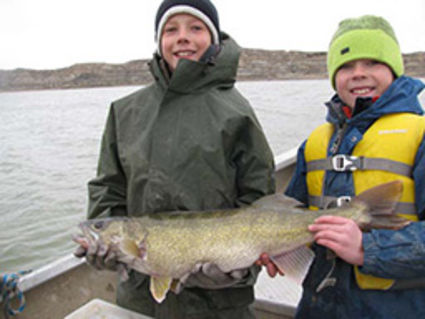Fort Peck Reservoir Walleye Spawn Egg-take Effort a Success, Stocking Fair
July 12, 2017

Montana Fish, Wildlife and Parks annual walleye spawn egg-take on Fort Peck Reservoir was completed at the end of April. In addition, stocking efforts were completed in June.
With the help of FWP personnel and over 95 volunteers, the egg collection goals were exceeded. Volunteers, Fort Peck Reservoir Biologist Heath Headley says, are key to the operation. "We wouldn't be able to set all the trap nets, collect fish, and spawn them on a daily basis unless we had help," he explained. "Volunteers are the main reason this has been so successful over the years."
A total of 2,261 walleye were captured in trap nets, with approximately 81 million eggs collected.
"The condition of some of the larger walleye was very impressive this spring," said Headley. "This is likely due to the high numbers of cisco, an important forage species, which we've had over the last couple of years. This abundance of food led to good growth and excellent egg production."
"One particular female walleye collected measured 29.8 inches, but weighed a whopping 14 pounds," said Headley. "We also observed a good number of mature walleye in the 20-25 inch range."
Roughly 45 million eggs remained at the Fort Peck Multi-Species Fish Hatchery, with about 36 million eggs going to the Miles City Hatchery. Combined stocking efforts from the Fort Peck and Miles City hatcheries resulted in approximately 26 million fry stocked back into the reservoir this spring.
In addition, approximately 1.8 million fingerlings from the hatcheries have been released into the reservoir recently.
Unfortunately, the production of fingerlings from the large numbers of eggs collected were not as successful as anticipated. According to Wade Geraets, the hatchery manager at the Fort Peck Multispecies Fish Hatchery, the warm, dry spring and summer in eastern Montana did not bode well for the final stages of walleye development at the Fort Peck hacchery.
"The weather made it difficult to keep the water temperatures at a safe level for these young fish at the hatchery," said Geraets. "Warm surface water temperatures, wind, and difficulties with our current water system resulted in the loss of some fish."
The hatchery has been looking at options to obtain cooler, more consistent temperature water from other sources, such as directly from the powerhouses at Fort Peck Dam. However, getting this potential change to happen has been taking some time.
"Presently, hatchery water is obtained from the Dredge Cuts, which can warm up quite quickly in the spring," said Geraets. "We have really struggled with our current water system this year."




